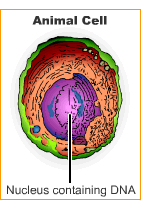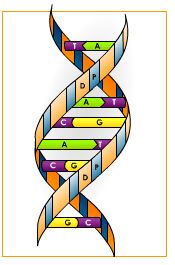|
Teacher Lesson Pages
 What’s so bad about radiation affecting human cells? The answer has to do with how your body works—cell by cell—and how your
body is organized from groups of cells into tissues, organs, and systems.
What’s so bad about radiation affecting human cells? The answer has to do with how your body works—cell by cell—and how your
body is organized from groups of cells into tissues, organs, and systems.
How does your body know how to work, what job to do, or even how to make more cells? Every cell of your body contains DNA,
which is the "programming," or instructions, that are needed by that cell to perform a job.
There are approximately 75 trillion cells in the human body. These cells form the tissues and organs that make up the 10
major systems of the human body: skeletal, muscular, circulatory, nervous, respiratory, digestive, excretory, endocrine,
reproductive, and immune. The DNA in each type of cell programs the cell to do its work.
 DNA
DNA
If you want to understand the human body, you must begin by becoming acquainted with DNA—deoxyribonucleic acid.
If you look closely at a strand of DNA, the first thing you will notice is its special shape. The double-helix structure of
DNA reminds many people of a twisted ladder. If you look carefully, you will see that this ladder is actually two chains of
molecules bound together.
Genes and Chromosomes—What’s the difference?
A segment of a DNA strand that programs a cell for a specific job is called a gene. This is a word you have certainly heard
of on the news. A gene is what determines a specific human characteristic. For instance, some genes determine your hair color,
eye color, the length of your bones (height), and the color of your skin. You have millions of genes in you. Your genes are
located within each cell. A gene is a segment of DNA on a chromosome—a structure in the cell nucleus that carries the genes
for specific traits.
Everyone Is Unique
The most incredible thing about genes is that all humans of every race, ethnic group, religion, and gender share 99.9 percent
of the same genes. The remaining 0.1 percent accounts for all the differences among human beings. Just think. There are more
than six billion people on this planet, yet 99 percent of the human “recipe” is identical. It is only one-tenth of 1 percent
of a person’s genetic code that makes every single person unlike anyone else.
So how did you receive the genetic coding that makes you unique? You inherited your parents’ genes.
Mutations
Mutations, or changes, can occur in the DNA’s structure if the molecules become exposed to too much radiation. The new
information, or programming, will now produce different instructions in new cells. When a cell reproduces, the new cell will
be different from its parent cell. In some cases of mutation, no real damage is done. In others the results can mean disease.
Shielding Protects Human Cells from Harmful Radiation
Mutations can occur naturally in the human body. They can also be caused by something in the environment—like the radiation from
a solar storm. This is why astronauts must take precautions to shield themselves from radiation during a solar storm. If they
receive too much radiation and a harmful mutation of a cell’s DNA occurs, they may suffer severe damage to their bodies.
Certain cells in the human body are more vulnerable to radiation than others. It is very important that these cells be protected
from radiation. If you ever have an X-ray, the chances are that parts of your body will be covered with a lead shield during the
procedure. The X-ray technician will also take precautions by moving behind a shielding wall.
The following cells are particularly vulnerable to harmful radiation:
- Cells found in the spleen, liver, and lymph nodes. These cells work, divide, and grow in order to keep the body healthy
by fighting disease and infection.
- Bone marrow cells, which form blood cells.
- Skin cells that line the digestive tract and lungs.
- Skin cells that form the outer layer of skin.
- Kidney cells that serve to remove wastes from the body's fluids.
Auntie’s Recipe
When you copy a recipe from your auntie’s cookbook and, quite innocently, leave out one, important "base" ingredient, the dish you
cook for Thanksgiving dinner will be a mutation of the original. It might taste OK (neutral), it might be simply awful (harmful),
it might even be more delicious than you remember (helpful). What are the odds?
The DNA recipe within your cells must be carefully protected, or your new cells will not be taking their instructions from the
original recipe. It is said that every seven years all of the cells in a body are "new." This does not happen all at once.
We protect our cell recipes by using sunscreen on our skin, by being careful around sources of damaging radiation, by not smoking
and damaging the fragile cells in our lungs, and by avoiding drugs that might change the cells in our nervous system. We can feed
our cells the right vitamins and proteins that will keep them “cooking.” The chemical reactions taking place in our bodies are
taking place at the molecular level, and yet they are as real as the atoms that form the ink on this sheet of paper.
Astronaut Safety
You can see why shielding procedures on the space station are so important to astronaut health. The astronauts live and work above
the protection of the Earth’s atmosphere and any type of protection against the many forms of radiation can help limit their career
build-up of radiation effects.
Check for Understanding
Answer the following questions to see how much you know about radiation.
- What is DNA, and what does it do?
DNA stands for deoxyribonucleic acid. It is your genetic code and is responsible for instructing or programming every
cell function.
- What is the difference between a gene and a chromosome?
A gene is a segment of a DNA strand that programs a cell for a specific job or characteristic. Some genes determine your
hair color, eye color, the length of your bones (height), etc. A chromosome is a structure in the cell nucleus that is made
up of genes.
- What is a mutation?
A mutation is any change, in this case a change in DNA structure in the cell. This would cause a change in cell function
and that change would be passed along to the new cell when the mutated cell reproduces.
- What is the danger to the astronauts of receiving too much radiation during a solar storm?
Radiation can change, or mutate, the DNA in the astronaut’s cells. This could disrupt cell function, cause more mutated
cells to be reproduced, and possibly lead to cancer.
- What types of body cells are particularly susceptible to harmful radiation?
Cells found in the spleen, liver, and lymph nodes, bone marrow, skin, and kidney.
|


